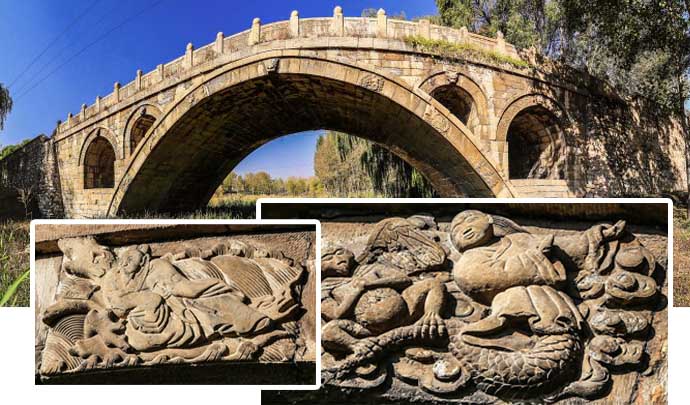Shanxi bridge carvings reference local Beijing legend

Reliefs about Beijing legend "Gao Liang’s quest for water" features the Puji Bridge in Shanxi Province.
Two ancient bridges built in the Jin Dynasty (1115-1234) still stand across Beijing's Yongding River and its tributary Sanggan River. One is the Lugou Bridge, built in 1192 in Beijing, and the other is the Puji Bridge, built in 1203 in Yuanping City, Shanxi Province. Though they were built centuries ago, these two bridges remain in pristine condition.
The stone carvings and ornaments on the two bridges display the typical distinctive artistic characteristics of the period. The two share some motifs. Both bridges are decorated with the head of Ba Xia, "one of the Dragon’s nine sons," who takes charge of water on the upper side of the bridge arch. They are decorated with different aspects derived from folk culture. The ornaments of the Lugou Bridge show various legendary animals, but those of the Puji Bridge emphasize legendary figures.
The ornaments of the bridge column head on the Puji Bridge include the Buddhist lotus and Buddha's hand instead of auspicious beasts. A series of reliefs, such as the flood dragon, auspicious clouds, the thunder god and dragon king adorn the rim of bridge arches that vary in size. Most of these ornaments reflect figures of Buddhism, Taoism, celestial culture and Confucianism. The main bridge arch has a group of successional reliefs about a popular folk legend in Beijing called "Gao Liang’s quest for water." Furthermore, the relief gate plaque is inscribed with the three Chinese characters Xizhimen, referring to one of the nine old city gates in Beijing, providing strong evidence to conclude that this group of reliefs reflects a legend in Beijing, and there are three relief figures on the gate. They are respectively Liu Bowen (1311-75), a military counselor and a founder of the Ming Dynasty (1368-1644); Yao Guangxiao (1335-1418), a monk and politician in the Ming Dynasty, and Gao Liang, a general about whom there is little extant historical information.
It is said that around the Ming Dynasty's Hongwu period from 1368 to 1398, Liu Bowen developed Beijing city under the reign of Zhu Yuanzhang (1328-98). According to legend, the place where Beijing now stands was occupied by a bitter sea. Liu filled up the bitter sea and established the city, and then the dragon king and dragon mother had no place to live. In an act of revenge, the dragon king and dragon mother planned to take away all the water in Beijing and dried all the wells. So Liu asked Gao Liang to stop dragon king and dragon mother and save the water source of Beijing city. This is the story of "Gao Liang’s quest for water." References to the legend are rare in classical documents or local literature. Over hundreds of years, this story was passed down orally, originating from street gossip as far back as the Han Dynasty (206 BC-AD 220). Although the story may sound absurd, and its time and location are ambiguous, it is tightly related to Beijing’s geographical features, human history, folk customs and beliefs, which definitely makes it worthy of the title "oral intangible cultural heritage in Beijing." But it is a mystery why a local Beijing legend would appear in northern Shanxi Province. Why do historical and legendary figures of the Ming Dynasty appear on a Jin bridge?
According to the rebuilding tablet set up in 1996 on the bridge, the Puji Bridge underwent two large-scale reconstructions in the Ming and Qing (1616-1911) dynasties. In particular, the Qing Dynasty’s reconstructions were carried out in 1755 and 1830 respectively, and the reliefs of "Gao Liang’s quest for water" on the bridge arch were likely added when the bridge arch collapsed during this period. The additional ornaments can be explained by the popularity of folk operas after the reign of Emperor Qianlong (1711-99) and to this day lyrics about the legend can still be found in local drum opera.
Zhou Huabin is from Communication University of China.

 PRINT
PRINT CLOSE
CLOSE